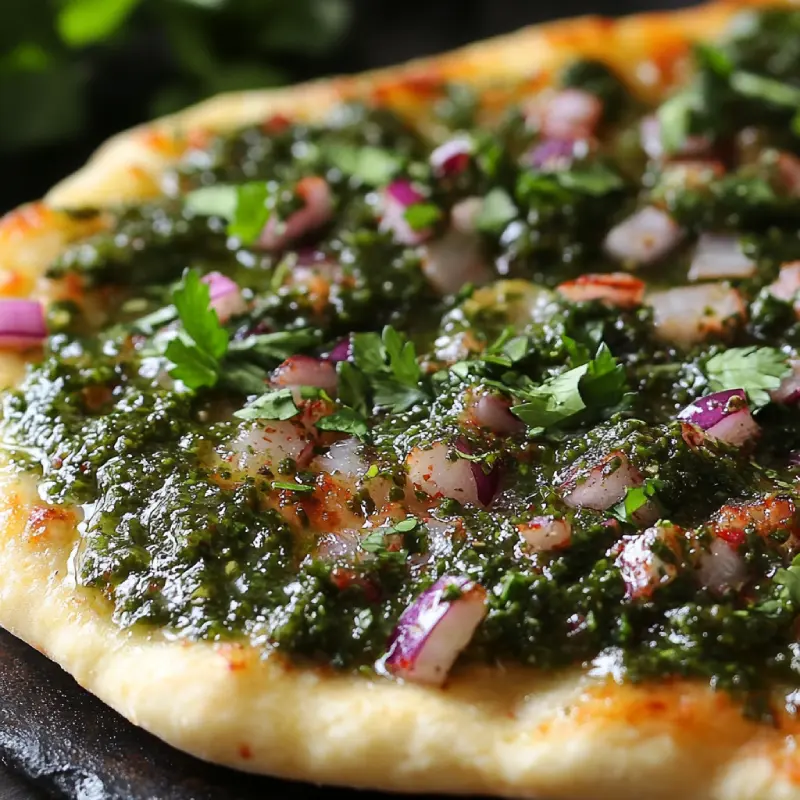Understanding Chimichurri Sauce
Introduction to Chimichurri (200 words)
Chimichurri sauce is a vibrant and herbaceous condiment that has its roots in Argentinian cuisine. It is traditionally served with grilled meats and is known for its bold, tangy flavor that can elevate a simple meal to something extraordinary. The primary ingredients in chimichurri include parsley, cilantro, garlic, olive oil, and vinegar, which combine to create its characteristic green color and refreshing taste. This sauce has gained international popularity, finding its way into kitchens and menus around the world, not only because of its simplicity but also due to its versatility in pairing with various dishes beyond its traditional use.
Ingredients and Preparation (300 words)
To make a traditional chimichurri sauce, you will need the following ingredients:
- Fresh parsley, typically one bunch
- Fresh cilantro, adding a slightly different green note
- Garlic, minced, for a sharp bite
- Olive oil, as the base of the sauce
- Red wine vinegar, for acidity
- Optional additions include red pepper flakes for heat and salt for seasoning
Step-by-step Preparation:
- Chop the Herbs: Finely chop the parsley and cilantro. The key to a great chimichurri is using fresh herbs for the best flavor.
- Mix Ingredients: In a bowl, combine the chopped herbs with minced garlic.
- Add Liquids: Pour in olive oil and red wine vinegar to the herb mixture. The oil and vinegar should emulsify slightly when whisked together.
- Season: Add salt and red pepper flakes to taste. Adjust these according to your preference for spice and seasoning.
- Let It Rest: Allow the sauce to sit for at least 15 minutes before serving. This resting period lets the flavors meld together beautifully.
Chimichurri sauce can be made in advance and stored in an airtight container in the refrigerator, where it can enhance in flavor. It’s a versatile sauce that can be adjusted based on personal taste preferences or available ingredients.
Crafting Chimichurri Pizza Sauce
Adapting Chimichurri for Pizza (300 words)
When transforming traditional chimichurri into a sauce suitable for pizza, several adjustments can enhance its compatibility with this beloved dish. Traditional chimichurri, known for its vibrant, herby freshness, usually serves as a condiment or marinade. However, when used as a pizza sauce, its consistency and flavor profile may need modification to better complement the pizza toppings and crust.
- Adjusting Thickness: To prevent the sauce from making the pizza dough soggy, reduce the amount of olive oil and vinegar slightly. This creates a thicker consistency that spreads evenly without dripping.
- Balancing Acidity: Since pizza dough and cheese can carry rich and heavy flavors, balancing the acidity in the chimichurri is crucial. Consider reducing the vinegar slightly or adding a touch of honey or sugar to cut through the sharpness, making the sauce more rounded and palatable when baked.
- Herb Proportions: Increase the proportion of parsley and cilantro to ensure that the fresh, green notes stand out against the robust flavors of cheese and other toppings.
For more tips on how to tailor traditional sauces for different culinary uses, visit culinary guides like Food Network.
Recipe for Chimichurri Pizza Sauce (400 words)
Creating a chimichurri pizza sauce that melds perfectly with the dynamic environment of a pizza oven involves enriching the traditional recipe with ingredients that complement the baking process and the final flavors of the pizza.
Ingredients:
- 1 cup finely chopped parsley
- 1/2 cup finely chopped cilantro
- 3-4 cloves of garlic, minced
- 1/2 cup olive oil
- 2 tablespoons red wine vinegar
- Juice of 1 lemon
- Salt and red pepper flakes to taste
- 1 teaspoon dried oregano
- Optional: 2 tablespoons grated Parmesan cheese or tomato paste for a twist
Instructions:
- Combine Herbs and Garlic: In a bowl, mix the parsley, cilantro, and garlic.
- Add Liquids: Stir in the olive oil, vinegar, and lemon juice. Mix until all ingredients are well combined.
- Season: Add salt, red pepper flakes, and oregano. Adjust these according to taste.
- Enhance for Pizza: For a pizza-specific twist, stir in Parmesan cheese or a small amount of tomato paste. This adds a new depth of flavor and helps the sauce meld better with typical pizza toppings.
- Rest: Let the sauce sit for at least 30 minutes before spreading on your pizza dough, allowing the flavors to integrate fully.
This chimichurri pizza sauce can be prepared ahead of time and refrigerated, making it a convenient and flavorful base for your next pizza night.
Application and Baking Techniques
Applying Sauce to Pizza (300 words)
Effectively applying chimichurri sauce to pizza dough is key to maximizing flavor without overwhelming the base. Here are some techniques to ensure even coverage and optimal taste:
- Amount of Sauce: Start with a moderate amount of chimichurri—about 2 to 3 tablespoons for a standard 12-inch pizza. You can adjust based on personal preference, but the goal is to cover the dough lightly without making it soggy.
- Spreading Techniques: Use the back of a spoon or a ladle to spread the sauce evenly across the dough, leaving about half an inch of the edge sauce-free to form a crust. For a more uniform distribution, you can also use a pastry brush to lightly coat the surface.
- Layering: If you’re adding other wet ingredients like tomatoes or buffalo mozzarella, consider layering some chimichurri sauce both under and over the toppings to infuse flavor throughout.
Baking Tips (300 words)
Baking pizza with chimichurri sauce requires careful attention to temperature and timing to enhance the flavors without burning the sauce:
- Oven Temperature: Preheat your oven to the highest setting, typically between 450°F to 500°F. High heat helps to quickly crisp the dough while melting the toppings evenly.
- Using a Pizza Stone or Steel: For the best crust texture, use a pizza stone or steel. These tools help distribute heat evenly and draw moisture away from the dough, creating a crispier bottom. Place the stone or steel in the oven during preheating.
- Baking Time: Bake the pizza for about 10 to 15 minutes, or until the edges are golden and the cheese (if used) is bubbly. Keep an eye on the pizza to prevent the edges of the sauce from charring.
- Post-Baking: After removing the pizza from the oven, let it rest for a few minutes. This allows the sauces and oils to settle, making it easier to slice and serve.
Adhering to these baking tips ensures that the unique flavors of the chimichurri are highlighted without overpowering the other elements of the pizza.
Serving and Additional Tips
Serving Suggestions (200 words)
Serving your chimichurri pizza with the right garnishes can greatly enhance the dining experience. Here are some creative ideas:
- Fresh Garnishes: After baking, top the pizza with fresh herbs like cilantro or parsley to enhance the vibrant flavors of the chimichurri. A sprinkle of fresh arugula can also add a peppery note.
- Cheese Options: Although chimichurri traditionally doesn’t include cheese, a light dusting of freshly grated Parmesan or crumbled feta can add a delightful contrast without overwhelming the herbal notes.
- Drizzles: For an extra touch of flavor, consider a drizzle of high-quality olive oil or a balsamic reduction immediately before serving.
These suggestions aim to complement the bold flavors of the chimichurri sauce, making each bite both unique and memorable.
Pairings (200 words)
Selecting the right side dishes and beverages can complement the unique taste of chimichurri pizza:
- Side Dishes: Pair the pizza with a light, crisp salad like a Caesar or a simple mixed greens salad dressed with lemon vinaigrette to balance the richness.
- Beverages:
- Wine: A glass of Sauvignon Blanc or a light-bodied Pinot Noir can harmonize beautifully with the herbal and tangy profile of chimichurri.
- Beer: Choose a crisp lager or a slightly hoppy pale ale that can refresh the palate without competing with the flavors of the sauce.
These pairings are designed to enhance the enjoyment of chimichurri pizza, creating a balanced and satisfying meal.
Frequently Asked Questions
Here are answers to some common queries about making and using chimichurri pizza sauce:
- How should I store leftover chimichurri pizza sauce?
- Leftover sauce can be stored in an airtight container in the refrigerator for up to a week. Ensure the container is sealed properly to maintain freshness and prevent contamination from other foods.
- Can I freeze chimichurri pizza sauce?
- Yes, chimichurri pizza sauce freezes well. Pour the sauce into ice cube trays or a freezer-safe container, and it should last for up to three months. Thaw in the refrigerator overnight before using.
- What are some alternative uses for chimichurri pizza sauce in various dishes?
- Beyond pizza, chimichurri sauce can be a versatile condiment or marinade:
- As a Marinade: Use it to marinate chicken, beef, or vegetables before grilling or roasting.
- In Sandwiches: Spread it on sandwiches or wraps for an herby kick.
- With Eggs: Drizzle over scrambled or poached eggs for a fresh, herby flavor.
- Beyond pizza, chimichurri sauce can be a versatile condiment or marinade:
- How can I adjust the consistency of chimichurri sauce for use as a pizza sauce?
- If you find the sauce too thin for pizza, reduce the olive oil slightly or add a small amount of tomato paste to thicken it without altering the flavor profile too significantly.
Conclusion
Creating the perfect chimichurri pizza sauce combines traditional Argentinian flavors with the classic Italian dish to create a unique and delicious culinary experience. Here are some key points to remember:
- Experiment with Flavors: Don’t hesitate to adjust the chimichurri ingredients to better match your taste preferences or the specific requirements of your pizza. Experimenting with different herbs, adjusting the acidity, or adding new elements like smoked paprika can lead to exciting new flavors.
- Utilize Leftovers Creatively: Any leftover chimichurri pizza sauce can be repurposed in various ways, enhancing not just pizzas but also meats, eggs, and sandwiches, making it a versatile addition to your culinary toolkit.
- Explore Further: Continuously exploring and learning about new ways to adapt and use chimichurri will elevate your cooking skills and broaden your flavor horizons.
This guide aims to inspire your cooking adventures, encouraging you to blend international cuisines and create dishes that delight the senses and bring joy to the table. Whether you’re a seasoned chef or a casual home cook, the journey of culinary creativity is boundless.

